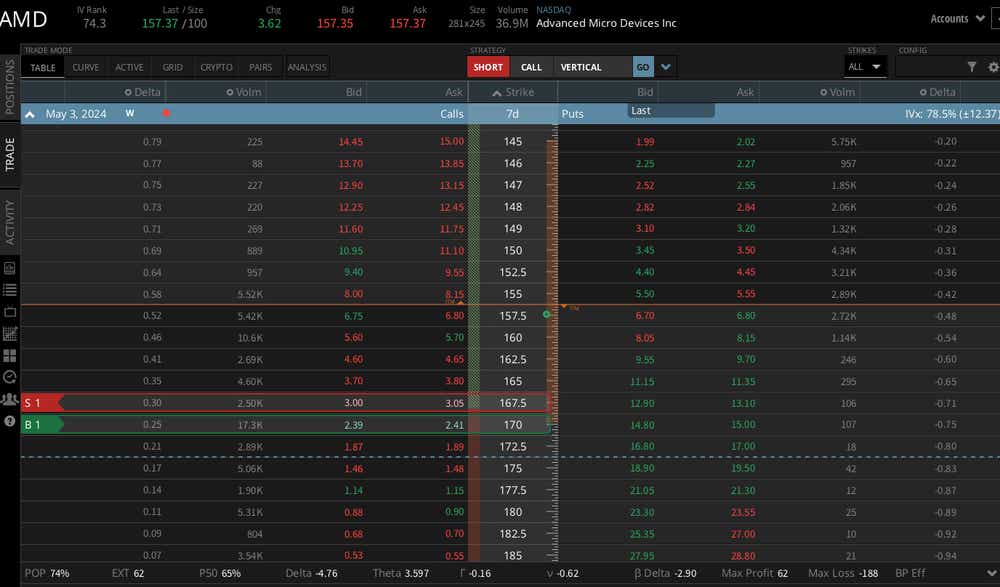What Investors Should Know About Advanced Micro Devices

What Investors Should Know About Advanced Micro Devices
AMD is scheduled to report earnings Tuesday—can the stock prevail after Intel’s plunge?
AMD is scheduled to report earnings on Tuesday, April 30.
Earnings per share of $0.62 and revenue of $5.48 billion are expected.
Options are loaded with premium amid high implied volatility rank.
Investors look to AMD after Intel outlook drags the chip sector
Advanced Micro Devices (AMD) is scheduled to report earnings on Tuesday, April 30. The chipmaker is expected to report earnings per share (EPS) of $0.62 for the January to March quarter, which would be a decrease from last quarter’s $0.77 EPS. However, it would top last year’s Q1 EPS of $0.60.
Revenue is expected to come across the wires at $5.48 billion. That would be down from last quarter’s $6.17 billion but up from the same period last year when AMD posted revenue of $5.35 billion. Comparing earnings to the same period from the prior year offers a better snapshot of performance because chip sales are influenced—like many consumer products—by seasonality.
AMD’s rival Intel (INTC) dropped nearly 10% today after reporting a disappointing revenue outlook. Markets contained the selling to INTC, with AMD rallying over 2%. That suggests INTC’s problems are specific to itself and not to the broader industry. In fact, Intel faces problems that may provide anopening for AMD. Intel is undergoing a transformational phase, which creates drag on the company’s effectiveness to concentrate its energy on sales and innovation.
While soft guidance will remain the potential headwind for a negative earnings reaction, investors will dig into other areas to assess AMD’s longer-term prospects. Specifically, investors want to see how its sales of graphic processing units (GPUs) are doing as it attempts to capture market share from Nvidia (NVDA). Still, broader chip sector woes remain largely in place.
Analysts remain largely bullish on the stock, with 31 of them assigning a strong buy rating, eight giving it a buy rating, nine choosing a hold rating and only one providing a sell rating, according to TradingView data. Among 41 analysts who offer price targets, the average one-year target is 201.63, which represents a 28% gain from Friday’s price of 157.41.
Trading AMD earnings
AMD hit an all-time high of 227.30 back in March, but the stock has dropped 30% since then. For reference, INTC is down just slightly more over the same time frame, and SMH—the VanEck Semiconductor exchange-traded fund (ETF) is down about 9%.
The stock is trading with an implied volatility rank (IVR) of 74.8. That is juicing up its options prices with a considerable amount of premium. That said, those looking to sell premium against earnings have their pick of choices, whether going long, short or neutral.
The May 3 strike shows an implied move of +/- 12.49 points. An example trade going on the neutral to bearish side is exampled by a short call vertical at the 30 delta, selling the 167.5 call and buying the 170 call. That trade would give a hypothetical max profit of $62 and max loss of $186, with a probability of profit of 74%.

Thomas Westwater, a tastylive financial writer and analyst, has eight years of markets and trading experience. @fxwestwater
For live daily programming, market news and commentary, visit tastylive or the YouTube channels tastylive (for options traders), and tastyliveTrending for stocks, futures, forex & macro.
Trade with a better broker, open a tastytrade account today. tastylive, Inc. and tastytrade, Inc. are separate but affiliated companies.
Options involve risk and are not suitable for all investors. Please read Characteristics and Risks of Standardized Options before deciding to invest in options.